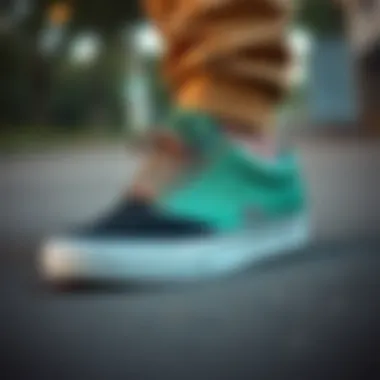Green Vans: The Future of Sustainable Skateboarding Footwear


Intro
In the world of skateboarding, footwear often takes the spotlight, playing a pivotal role in a skater's performance and style. Among the most notable innovations is the emergence of green vans, a trend that embodies a desire for sustainability without sacrificing quality or performance. The skateboard community is embracing eco-friendly materials and practices, reflecting a broader awareness of environmental issues. This article will delve into the specifics of how green vans are reshaping skateboarding footwear, focusing on materials used, manufacturing processes, and the resulting impact on both the skater and the planet.
Skateboarding Techniques
Mastering the Basics
To truly appreciate the significance of quality footwear, one must first grasp the fundamentals of skateboarding. Beginners often start by learning to push, ride, and stop effectively. These foundational techniques require a good grip from the shoes, enabling skaters to maintain balance while developing confidence on their boards.
When it comes to green vans, the grip is paramount. Many eco-friendly models incorporate rubber outsoles derived from recycled materials, providing that necessary traction without the environmental cost. Skaters can feel the difference when their footwear performs at peak levels, enhancing their experience and connection to the board.
Advanced Tricks and Stunts
Once a skater masters the basics, the focus shifts towards executing tricks and stunts. This includes ollies, kickflips, and grinds that demand precise foot placement and quick reflexes. The performance of green vans comes into play here as well. Designed to endure the wear and tear of frequent landings and slides, these shoes often showcase reinforced stitching and durable eco-forward materials. Skaters can push their limits, knowing their footwear can handle the demands of advanced maneuvers.
Gear and Equipment
Skateboard Types and Features
Every skater knows that the type of skateboard is essential to personal style and performance. From street decks to longboards, the variety is vast. Each type demands different characteristics from skateboard shoes. An eco-conscious approach to these shoes doesn't just enhance personal style; it also reflects a commitment to sustainable practices. Green vans typically emphasize lighter materials, which can boost maneuverability without sacrificing strength.
Essential Safety Gear
Safety should never take a backseat to style or performance. As skaters progress, they should consider complementary gear including helmets, knee pads, and elbow pads. The right safety gear protects skaters while they push the envelope during their sessions.
Wearing eco-friendly shoes not only supports a sustainable future but also encourages a culture of safety and responsibility among skateboarders.
"Choosing sustainable footwear doesn’t just benefit the wearer; it sends a message that the skateboarding community values the environment."
For further insights and discussions beneficial to the skateboarding and sustainability discourse, check these resources:
Intro to Green Vans
Skateboarding isn't just a sport; it’s a whole lifestyle, an expression of creativity, and for many, a pathway to freedom. As the world pivots towards a more sustainable future, the introduction of green vans resonates deeply within this vibrant community. Green vans symbolize a commitment not only to individual style but also to the environment. They showcase how the footwear industry can shift gears, embracing both quality and ecological responsibility.
Defining Green Vans
So, what exactly are green vans? At their core, they represent skateboarding shoes crafted with eco-friendly materials and sustainable practices. These are not your run-of-the-mill sneakers; they incorporate innovations such as recycled fabrics, biodegradable components, and ethically sourced materials. The significance of green vans lies in their dual purpose: providing skateboarders with the performance they demand while caring for the planet.
Choosing green vans isn't merely a trend; it reflects a broader consciousness about consumption and waste. When we talk about skate shoes that are designed with sustainability in mind, we’re spotlighting a shift in consumer priorities. This doesn’t mean sacrificing style or functionality but instead integrating ethical considerations into our everyday choices.
The Rise of Eco-Conscious Footwear
In recent years, a noticeable shift has taken place in consumer behavior. People are increasingly aware of how their purchases impact the environment, and skateboarding is no exception. The rise of eco-conscious footwear aligns perfectly with a generation determined to tread lightly on this planet. Skate culture, often at the forefront of social movements, is now embracing sustainability as a core value.
The change can be seen in various ways. Consumers, from seasoned skaters to novices, are actively seeking brands that prioritize environmentally friendly practices. Retailers are stepping up in response, curating collections that feature green vans prominently. Social media platforms, including Instagram and Reddit, have become breeding grounds for discussions about sustainability in skateboarding.
"Choosing green vans is about more than just footwear; it's about making a statement in favor of a healthy planet."
However, this change doesn’t just happen overnight. It requires continuous exploration of sustainable materials, means to lower production waste, and innovative designs that do not compromise on performance or style. As the market expands, it invites stakeholders—from manufacturers to retailers—to engage in meaningful dialogue about sustainability.
As supporters of the skate culture continue to advocate for green living, the popularity of green vans marks a significant step in the broader environmental movement. This section serves as a foundation for understanding the complexities and importance of sustainability in skateboarding, paving the way for a more profound examination of the materials and practices that are redefining what it means to be a skater in today’s world.
Sustainable Materials in Skateboarding


The use of sustainable materials in skateboarding footwear represents a vital stride towards a greener future. Not only do these materials reduce the environmental toll of producing skate shoes, but they also align with the principles of many skateboarders who value individuality and responsibility. Skateboarding culture has always been about innovation and creativity, and now it is finding new avenues to express those values through eco-friendly practices. The move to sustainable materials is not just a passing trend; it’s a fundamental shift that combines style, performance, and consciousness.
Recycled Fabrics and Components
Recycled fabrics serve as a cornerstone of sustainability in skateboarding shoes. Companies increasingly utilize materials derived from post-consumer waste, which not only decreases waste in landfills but often reduces energy consumption during production, too. For instance, instead of using virgin cotton or polyester, brands may opt for textiles made from recycled water bottles or worn-out garments. This approach not only conserves resources but can also create a unique aesthetic—each shoe may carry its own story within the fibers.
The benefits of recycling extend beyond simply being environmentally friendly. Skate shoes crafted from recycled textiles tend to be lighter and more comfortable, crucial aspects for skaters who spend hours on their feet. Moreover, when consumers see products marked as made with recycled materials, they are often more inclined to support them, thus creating a positive circular economy.
"Using recycled materials is not just about going green. It's about pushing the boundaries of our craft while respecting the planet we ride on."
Biodegradable Alternatives
Another exciting development in green skate footwear is the use of biodegradable materials. These alternatives, made from natural substances, can decompose within a reasonable timeframe, unlike conventional synthetic materials that can take centuries to break down. Brands have tapped into materials like organic cotton, hemp, and specific plant-based plastics, which, while offering high performance and comfort, reduce the impact on the environment after the product's life cycle ends.
Shifting to biodegradable options does pose some challenges. For example, while some biodegradable materials may require precise conditions to break down effectively, manufacturers are working to address these issues. As research in this field progresses, more effective and practical bio-based materials will likely emerge, making it easier for skateboarding footwear to navigate the intersection of performance and sustainability.
Natural Rubber and Foam Innovations
Natural rubber and foam innovations have also carved out a niche in the sustainable skate footwear landscape. Many brands are now replacing conventional synthetic rubber with natural rubber, sourced from rubber trees. This shift not only supports sustainable forestry practices but also yields a versatile material that provides excellent grip and durability, essential for any serious skater.
Moreover, advancements in foam technology are paving the way for more sustainable options. Producers are developing foams that are derived from renewable resources, delivering cushioning and shock absorption that skaters demand without relying on petroleum-based products. This blend of performance and responsibility is proving to be a game-changer within the industry.
Environmental Impact of Conventional Footwear
Footwear is often taken for granted, but its environmental footprint cannot be ignored. When we talk about the impact of conventional footwear, it becomes particularly pressing in the context of skateboarding culture. Skate shoes are part of a larger ecosystem that affects our planet, and understanding this impact can shed light on why a shift towards more sustainable options, like Green Vans, is essential.
Production Footprint of Standard Vans
The production of shoes, particularly those that are mass-produced like conventional Vans, has significant implications for the environment. Manufacturing processes often involve energy-intensive practices, not to mention the consumption of limited resources. For instance, the use of synthetic materials, mainly derived from petroleum, contributes heavily to carbon emissions.
Moreover, consider the manufacturing facilities, often located in regions where environmental regulations might not be as stringent. This can lead to waste discharge and air pollution, affecting local ecosystems and communities. The skateboarder community, inherently linked to outdoor environments, is affected if those environments deteriorate. In many ways, buying a pair of standard skate shoes is not just a personal choice but a decision that resonates throughout the ecosystem.
Waste and Longevity Issues
Once these shoes wear out, the problem magnifies. Conventional footwear often relies on materials that are not designed to decompose. This leads to a staggering amount of waste ending up in landfills. According to the Environmental Protection Agency (EPA), footwear contributes significantly to landfill mass, and given the average lifespan of skate shoes is relatively short due to the demands of the sport, this becomes a cyclical problem.
The concept of waste isn’t merely about disposal. It’s about longevity and how we frame our relationship with our belongings. Skate shoes, like many others, are often perceived as disposable. Yet, many skaters will wear down their shoes to the last shred of fabric and rubber before retiring them. However, while it’s admirable to extract as much use as possible, it also often leads to shoes that become unusable well before they need to leave our possession.
"An ethical skateboarding culture not only promotes skill on the board but extends to the choices we make off it."
Consequently, the focus on durability in alternative brands is paramount. Many new brands are striving to create shoes that last longer and are made from sustainable resources, attempting to bridge this gap between waste and utility. In turn, this could redefine how skaters view their gear, promoting a culture that values longevity and responsibility toward the planet.
By grasping the environmental impact of conventional footwear, skateboarders, parents, and retailers can appreciate why initiatives like Green Vans are not just beneficial alternatives, but necessary shifts towards sustainable practices. As the skate community continues to grow, so does its responsibility to embrace a future that seeks to minimize its footprint on the environment.
The Performance Aspect of Green Vans
In the bustling world of skateboarding, performance is the name of the game. When it comes to footwear, the performance of green vans plays a pivotal role not only in how skaters ride but also in ensuring that they’re making responsible choices for the planet. Eco-friendly materials don't just check the "green" box—they also deliver on function, comfort, and durability. This part of the article will delve into two critical aspects: comfort and fit, alongside traction and grip dynamics.
Comfort and Fit Considerations
Comfort in skateboarding shoes is crucial. A good fit means skaters can ride longer without discomfort, and this is where green vans shine brightly. These shoes are designed not just with sustainability in mind, but with the anatomy of a skater’s foot at heart.
- Customized Inserts: Many brands are now incorporating recyclable EVA insoles, which adapt to the foot's shape over time, offering unparalleled support. Whether it’s a casual street session or a rigorous skate park day, comfort can’t be understated.
- Breathability: Often neglected, breathability can make or break a session. Constructing shoes with recycled mesh allows for optimal airflow, reducing sweat and keeping feet fresh.
- Natural Fit: The trend of using organic materials aims at creating a snug but comfortable fit that feels like a second skin. This aspect is especially important on long board rides where as hours go by, the fit can adjust slightly.
The comforting embrace of well-crafted, eco-conscious shoes not only enhances performance but also ensures skaters can express themselves freely without the nagging urge to remove their shoes due to discomfort.
Traction and Grip Dynamics


When it comes to skateboarding, having a reliable grip is just as vital as comfort. Green vans utilize innovative material technologies that enhance traction while also being environmentally responsible.
- Natural Rubber Soles: Many manufacturers are turning to sustainable rubber harvested from rubber trees. This rubber isn’t just eco-friendly; it has excellent grip dynamics that allow for powerful maneuverability on the board.
- Innovative Patterns: Designs in the outsole can increase contact with skate surfaces, leading to better grip. Brands are focusing on unique tread patterns that perform just as well, if not better, than conventional options.
- Durability vs. Grip: Traditionally, there used to be a trade-off between durability of materials and grip. However, with advancements in technology, many green vans now provide impressive durability while maintaining optimal grippy surfaces, meaning the shoes can handle tricks and grinds without easily wearing down.
"The perfect balance of comfort and grip makes all the difference in the skateboarding experience; this is where the future of green vans truly lies."
Ultimately, the performance aspect of green vans is about more than just enjoying a good ride. It’s about the synergy of having shoes that take care of the user’s needs while also prioritizing the health of the environment. In a world that’s becoming increasingly populated by conscious choices, opting for footwear that encapsulates performance, comfort, and sustainability isn’t just wise—it’s revolutionary.
Consumer Perceptions and Trends
In the ever-evolving world of skateboarding, consumer perceptions heavily influence product trends and market evolution. As skateboarding moves towards sustainability, the shifting mindset of skateboarders, parents, and retailers plays a crucial role. Consumer interest in eco-friendly practices is on the rise, signaling a collective consciousness toward sustainable living. People are increasingly considering the environmental impact of their purchases, especially in a culture that aims for authenticity and ethics in its choices.
Increasing Demand for Sustainability
The demand for sustainable products isn't just a passing trend; it reflects an ongoing transformation in consumer values. Recent surveys and studies show a growing segment of consumers willing to pay more for footwear that is made with eco-friendly materials.
- Awareness: Many skateboarders are now educated about the environmental consequences of traditional manufacturing practices, leading them to seek alternatives. From the production processes that cause pollution to the microplastics ending up in oceans, the awareness about these issues drives demand for greener options.
- Brand Loyalty: Skateboarders are gradually shifting their loyalty toward brands that align with their values. They are opting for companies that not only produce high-quality footwear but do so through ethical practices. This growing loyalty makes it crucial for brands to adjust their offerings.
- Community Influence: The skateboarding community fosters peer-to-peer influence, where word of mouth can significantly boost the popularity of brands promoting sustainable practices. The inclination to wear what friends wear translates into the main driver for sustainable options in footwear.
Influence of Skate Culture on Consumer Choices
Skate culture operates on a unique social fabric; decisions about gear aren't solely personal—they're communal. The influence of skate culture on consumer choices is profound, with certain styles and brands becoming synonymous with the lifestyle.
- Cultural Symbolism: Many consumers tend to view skate shoes as more than just functionality; they are symbols of identity. As sustainable brands penetrate the market, they are embraced by skaters as a badge of honor, representing a commitment not just to style, but also to environmental responsibility.
- Shifting Ideals: The rise of influencers and well-known skaters advocating for sustainability has changed the landscape dramatically. If a popular skater endorses a green brand, their fanbase is likely to follow suit—driving sales and popularity.
- Subcultures and Diversity: Skateboarding is a melting pot of diverse communities, each bringing their values and ideologies into the mix. Brands that resonate with various subcultures within skating—including those that focus on environmental responsibility—can pull in a wider audience.
"Choosing green footwear goes beyond simply stepping on skateboards; it embodies a commitment to shape the future sustainably."
The evolution of consumer perceptions and trends in the skateboarding community is clear. There is an increasing awareness about the significance of making sustainable choices that not only impact their skateboarding experience but also contribute positively to the environment. Brands that recognize and adapt to these shifting trends are better poised to thrive in this new market landscape.
For further exploration:
Challenges in Sustainable Production
Sustainable production is a hot potato in the skateboarding footwear industry, especially when talking about green vans. As the world gears up for eco-conscious initiatives, skateboarders and manufacturers alike face a jumble of hurdles. Each challenge underscores the necessity of striking a balance between making shoes that not only skate well but also make environmental sense. Addressing these challenges can lead to significant strides towards a more sustainable skate culture.
Supply Chain Complexities
To get eco-friendly shoes on our feet, we must look at the intricate web of the supply chain. Getting sustainable materials, like organic cotton or recycled plastics, from point A to point B isn't a walk in the park. The whole process can feel like herding cats. Suppliers must meet specific certifications and standards to ensure that their materials are genuinely green. This means auditing processes, verifying sources, and a lot of back-and-forth communication.
These complexities don’t just slow down production; they also drive up costs.
- Logistical Challenges: Often, sustainable materials are sourced from diverse locations that may not be locally accessible, leading to longer lead times.
- Quality Assurance: Ensuring that every element of the supply chain meets environmental standards requires painstaking oversight that can complicate relationships with suppliers.
- Transparency Issues: Brands want to show authenticity to their customers yet must navigate a multitude of vendors. A lot of players in the chain often leads to questions about who’s really behind what we wear.
In the eco-conscious world, the mantra is 'the more you know.' This is especially true when it comes to sourcing materials.
Cost Implications for Manufacturers
As we peer into the costs of sustainable production, it’s clear the financial implications shouldn't be taken lightly. Adopting greener production methods often leads to higher initial expenditures. Organic fabrics, low-impact dyes, and sustainable adhesives generally don’t come cheap.
- Raw Material Expenses: Many manufacturers face steep unit costs for responsibly sourced materials compared to conventional options. Attempting to keep a competitive price while ensuring sustainability can be a tall order.
- Technology Investments: Advances in green technology require continuous investment. Initially, those costs cascade down to consumers. If manufacturers are going to create innovative, sustainable footwear, they must invest in newer, cleaner equipment and processes, which can put a strain on their budgets.
- Economies of Scale: While there’s increasing demand for green products, many companies are still operating at a smaller scale. Until they reach that sweet spot where production costs drop, passing on those savings is often impossible.
The balance sheet tells only part of the story in the sustainable revolution. Skateboarders, parents, and retailers must come to terms with the idea that eco-responsibility might come at a price, but it’s an investment in the future.
Consumer Awareness and Education
Navigating the road to sustainability requires not just a shift in production but also in consumer perception. As brands strive to make green vans the go-to choice, raising awareness and educating consumers about the importance of these efforts plays a pivotal role.


- Understanding Sustainability: Many consumers still have a long way to go in understanding the importance of sustainable footwear. Skateboarders might prioritize brand image or the latest design over eco-friendliness. It becomes vital for manufacturers to communicate the benefits effectively.
- Grassroots Campaigns: Innovators can engage directly with their audience through workshops, social media, and skate events, showing how sustainability plays a role in the quality of their products.
- Building Trust: When brands take extra steps to educate consumers and demonstrate transparency, they build trust. People are generally more willing to choose sustainable options when they see a real commitment behind them, not just green-washed marketing.
In the end, consumer awareness goes hand in hand with sustainable production. The green revolution in skate footwear will thrive only when consumers are not just aware of the challenges but also invested in the solutions.
Case Studies of Green Vans Brands
In the evolving landscape of skateboarding, green vans have carved out a vital niche. This section delves into noteworthy case studies, showcasing brands that lead the charge in sustainable practices. The importance of these examples stems from their roles as beacons for the industry, illustrating how eco-friendly initiatives can be attuned with performance and style. Each case study highlights different innovative practices, market reception, and the ultimate impact on the sustainability conversation within skate culture.
Innovative Practices from Leading Companies
Several companies are frontrunners when it comes to integrating eco-friendly practices into their product lines. Brands like Vans, Nike SB, and Etnies are not just producing footwear; they are changing the way footwear is made. For instance:
- Vans has initiated a program that emphasizes the use of recycled materials in their shoe production. An example would be their collaboration with Eco-Textiles, creating shoes that feature organic cotton and recycled rubber. This not only minimizes their environmental footprint but also provides customers with a product they can feel good about wearing.
- Nike SB has launched a line specifically designed around sustainability. Their materials include recycled denim and alternative leathers, emphasizing the reduction of waste in both production and packaging. This not only cuts down on the harmful impact associated with traditional manufacturing but also attracts a consumer base that values environmental responsibility.
- Etnies prides itself on having a ‘buy a shoe, plant a tree’ initiative, which contributes to reforestation efforts alongside footwear sales. Their eco-wool and recycled plastics in footwear further amplify their commitment, making them a pioneer in sustainable skateboarding footwear.
These brands demonstrate how eco-innovation can coalesce with stylish and functional designs, making green vans appealing to a broad audience.
Success Stories and Market Reception
The reception of eco-conscious footwear during recent years has been promising. As the push for sustainability grows, so does consumer awareness and appetite for brands that prioritize the planet.
- Vans, for instance, reported an impressive increase in sales among their eco-friendly product lines. A growing number of consumers are now consciously choosing these options, indicating that environmental responsibility is becoming a deciding factor in purchasing behavior.
- Nike SB's sustainability initiatives received accolades from industry insiders. The positive reception has positioned them as a thought leader in the conversation around sustainable practices in athletics and streetwear.
- Etnies, too, has leveraged social media networks to amplify their initiatives. Their campaigns, which spotlight environmental accountability, resonate well with both skateboarders and casual customers. The community’s embrace and advocacy for these practices have created a positive feedback loop, encouraging further innovation.
"The real success lies not just in what is sold but in how it is perceived; consumers today resonate with brands that mirror their values."
Future of Sustainable Footwear in Skateboarding
The future of sustainable footwear in skateboarding holds exciting promise, especially as the industry witnesses a shift towards environmentally responsible practices. Skateboarders, parents of young riders, and retailers are increasingly becoming aware of the impact that conventional shoe production has on the planet. The demand for eco-friendly options is no longer a niche preference but a significant trend reshaping the footwear landscape. Understanding this transition is crucial as it not only reflects consumer conscience but also illustrates the shifting dynamics of skate culture itself.
Emerging Technologies and Their Implications
Emerging technologies are paving the way for innovative solutions in the production of skateboarding footwear. Advanced materials that are both durable and sustainable are being developed, focusing on minimizing waste and enhancing recyclability. For instance, companies are harnessing methods such as 3D printing to create shoes with precision, which cuts down on excess material usage. Additionally, bio-based materials derived from algae or recycled plastics are entering the market, offering consumers a more sustainable option sans the traditional carbon footprint.
- 3D Printing: This modern technology allows manufacturers to produce shoes on-demand, reducing waste associated with overproduction.
- Bio-Based Materials: Materials crafted from renewable sources, such as algae or corn, provide an alternative to petroleum-based products, benefiting the environment.
- Recycling Initiatives: Some brands have introduced recycling programs where consumers can return used shoes for repurposing, closing the loop in product life cycles.
The implications are significant; these technologies can lead to not only eco-friendlier products but also lower production costs over time as processes become more efficient. Future generations of skateboarders might just slip into shoes that are as green as they are durable, all while enjoying superior performance.
Potential for Industry-Wide Change
The potential for industry-wide change is a conversation that’s beginning to gain traction among skateboarding brands. As awareness grows, companies that embrace sustainability may capture greater market share by appealing to an eco-conscious consumer base.
Here are some key impacts of this potential shift:
- Market Differentiation: Skate brands that invest in sustainable practices will distinguish themselves in a crowded marketplace, appealing to a demographic that values both performance and environmental responsibility.
- Collaboration and Partnerships: Increased collaboration amongst brands, NGOs, and government initiatives can foster an integrated approach to sustainability that encompasses the entire supply chain.
- Consumer Education: As companies shift towards greener practices, educating consumers on the life cycle of their footwear and the importance of sustainable choices becomes vital.
"The shift from conventional materials to sustainable alternatives signals a broader cultural change that extends beyond footwear—it reflects a new way of thinking among skateboarders and consumers alike."
Ultimately, the trajectory ahead shows a vibrant future for sustainable footwear in the skateboarding niche. By embracing greener technologies and practices, the skate community can lead by example, inspiring change that reverberates across the entire industry. The call for sustainability is real; it’s not just a trend, but a necessity for a responsible skating culture.
Culmination
In the ever-evolving landscape of skateboarding footwear, the emergence of green vans represents not just a trend, but a necessary shift toward sustainability. Understanding the essence of green vans is pivotal for both consumers and manufacturers, as it serves as a reflection of broader societal values prioritizing environmental responsibility. The importance of this topic is highlighted through several key elements:
- Environmental Responsibility: The production of conventional footwear contributes significantly to waste and pollution. Green vans, however, prioritize materials that minimize environmental impact, paving the way to a more sustainable industry.
- Performance and Durability: There's often skepticism around the performance of eco-friendly products. Green vans have disproven this notion by integrating innovative materials that maintain, if not enhance, comfort, grip, and overall performance. Skateboarders can enjoy not only style but also functionality without guilt.
- Consumer Awareness: As skate culture evolves, consumers are becoming more discerning about their choices. Educating skateboarders, retailers, and parents about the benefits of green vans is crucial. It fosters a community that values sustainable practices and promotes a positive image of skateboarding.
- Market Dynamics: The success stories of various sustainable brands illustrate a growing market demand for eco-conscious products. By investing in green vans, manufacturers can tap into this lucrative market while contributing to long-lasting change.
- The Collective Effort: Embracing sustainability in skateboarding is not merely a solo journey; it's a collective one. By supporting brands committed to greener practices, every skateboarder becomes an active participant in the movement towards positive change.
"The future of skateboarding relies heavily on our willingness to adapt and embrace the changes that green vans represent. It's about more than just footwear; it's about setting a trend that values our planet."
The Path Forward for Green Vans
To forge ahead in this sustainable revolution, it’s essential for manufacturers, consumers, and the entire skate community to adopt certain considerations:
- Collaboration with Material Innovators: Brands should seek partnerships with companies that specialize in sustainable materials, fostering an ecosystem that encourages responsible manufacturing.
- Emphasis on Transparency: Open communication about production processes and sourcing can build trust with consumers. Skateboarders want to know where their shoes come from and the impact they have.
- Engaging the Youth: Educating young skaters on sustainability can foster a new generation of eco-conscious consumers. Workshops, events, and social media campaigns can engage and inform this demographic effectively.
- Continuous Research and Development: The industry must prioritize R&D to keep innovating sustainable solutions. Whether it’s the introduction of new materials or manufacturing techniques, staying ahead of the curve is critical.
- Feedback Loops from Consumers: Gathering insights from consumers who embrace green vans can drive improvements in design and functionality, ensuring that the products meet the needs of the market.
By leaning into these strategies, we can hope to see a future where green vans not only provide footwear but also embody a commitment to the planet and the skateboarding community. The momentum is building, and with collective effort, the path forward can lead to a radical transformation in how we perceive and participate in skate culture.















